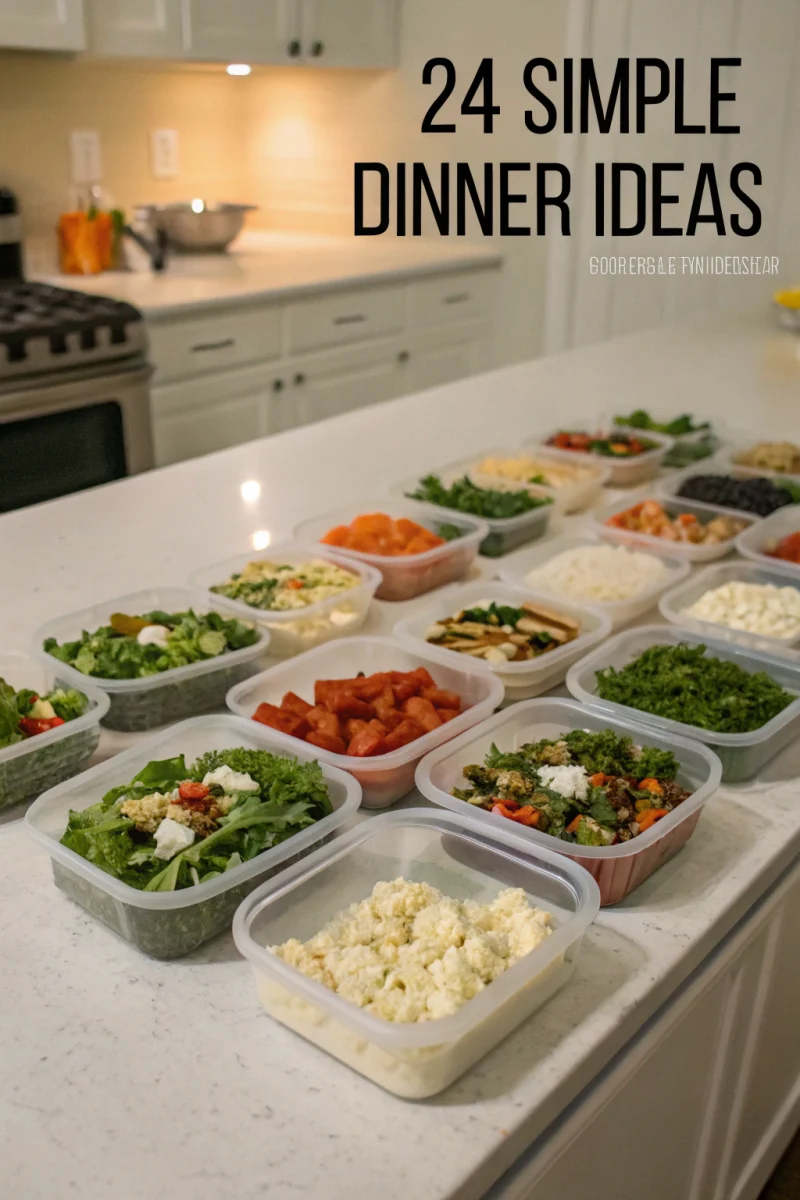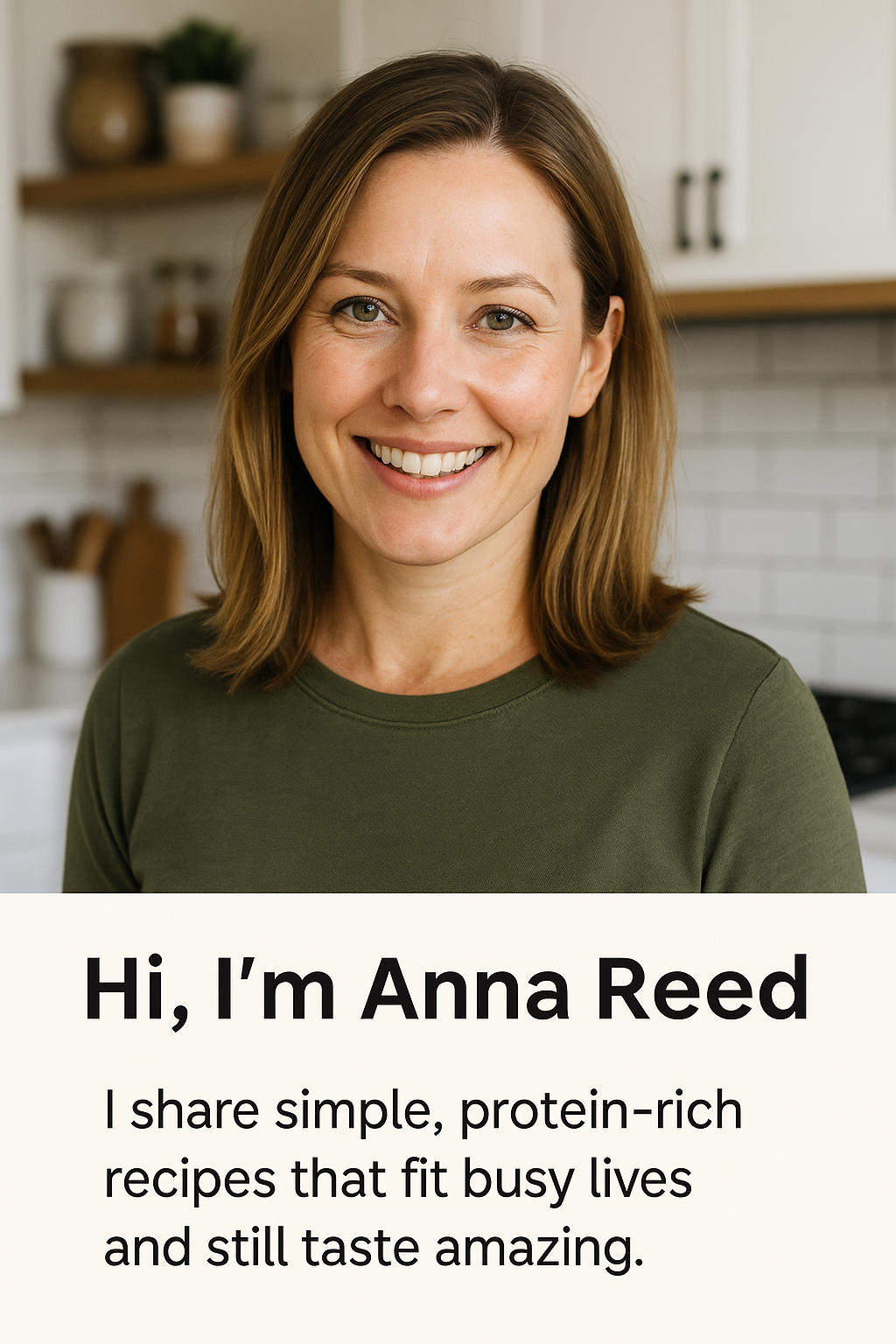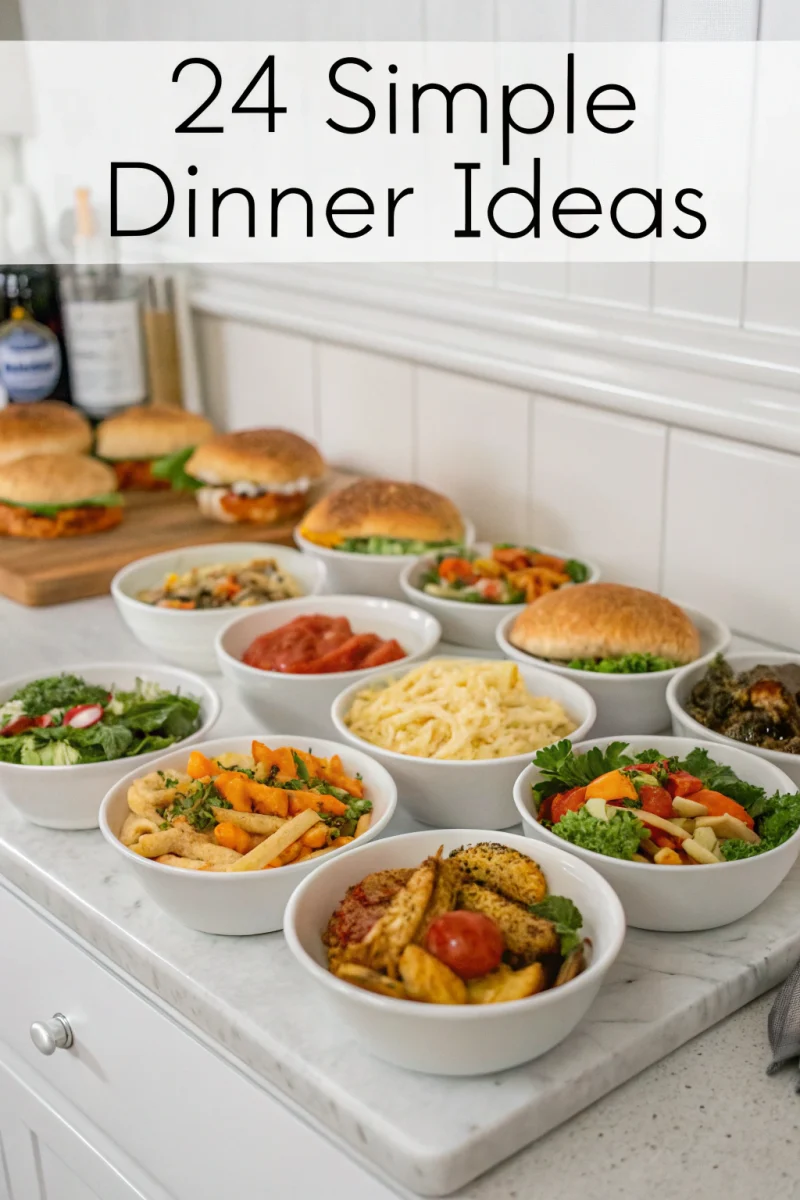Introduction
Quick and Simple Dinner Ideas help turn weeknights into calm, tasty moments without marathon cooking sessions. Are you tired of staring into your fridge, wondering what to make for dinner that’s both delicious and doesn’t take forever? Many home cooks believe that genuinely satisfying meals require significant time and effort. However, with the right approach, preparing a variety of quick and simple dinner ideas can become a stress-free reality, transforming weeknight meals into enjoyable experiences rather than dreaded chores. This guide focuses on innovative, achievable recipes that bring flavor and efficiency to your kitchen.
Q: What counts as a “quick” dinner on busy nights?
A: Aim for 30 minutes total with minimal prep and one or two pans.
Ingredients List

Here are the pantry staples and fresh items you’ll need for many of these quick and simple dinner ideas:
- Proteins: 1 lb boneless, skinless chicken breasts (tender, versatile), 1 lb ground turkey (lean and flavorful), 4 large eggs (nutrient-rich).
- Alternative: Firm tofu for a vegetarian protein, canned chickpeas for a convenient option, or pre-cooked rotisserie chicken to save time.
- Vegetables: 1 head broccoli (crunchy, vibrant green), 2 bell peppers (any color, sweet), 1 onion (aromatic base), 2 cups spinach (wilts down easily).
- Alternative: Frozen mixed vegetables for ultimate convenience, pre-cut veggie trays from the store, or kale for an earthier flavor.
- Carbohydrates: 1 cup quinoa (fluffy, protein-packed), 4 tortillas (soft and foldable), 1 cup pasta (short shape works best).
- Alternative: Brown rice for a nuttier chew, corn or flour tortillas depending on preference, or whole wheat pasta for added fiber. For grain-based bowls, see our healthy grain bowl ideas.
- Pantry Essentials: Olive oil, garlic powder, onion powder, salt, black pepper, soy sauce, lime juice, honey.
- Alternative: Avocado oil for higher smoke point, Italian seasoning blend, tamari for gluten-free diets, or lemon juice for brightness.
Q: Which staples should I buy in bulk for fast dinners?
A: Whole grains, canned beans, frozen veg, eggs, and versatile seasonings cover most weeknights.
Prep Time
- Prep time: 10 minutes
- Cook time: 15-20 minutes
- Total time: 25-30 minutes
This collection of simple dinner ideas is approximately 25% faster than complex, multi-component meals often found in cookbooks.
Q: How do I consistently hit 30 minutes?
A: Start carbs first, cook protein while chopping veg, and finish with a quick sauce in the same pan.
Preparation Steps
Step 1: Gather and Measure
Before you begin, gather all your ingredients and measure them out. This practice, known as mise en place, ensures a smooth cooking process and prevents last-minute scrambling.
Step 2: Chop Your Produce
Dice your onion, slice your bell peppers, and chop your broccoli into bite-sized florets. A sharp knife makes quick work of this task.
- Practical tip: Use a food chopper for an even faster way to prepare onions and peppers.
Step 3: Cook Your Protein
Heat a tablespoon of olive oil in a large skillet over medium-high heat. Add your chosen protein (chicken, ground turkey, or tofu). Cook until browned and cooked through, breaking up ground meats with a spoon. Season with garlic powder, onion powder, salt, and pepper.
- Practical tip: Don’t overcrowd the pan; cook in batches if necessary to ensure a good sear rather than steaming.
Step 4: Add Vegetables
Once the protein is cooked, add the chopped bell peppers and broccoli to the skillet. Sauté for 5-7 minutes until the vegetables are tender-crisp. Stir in the spinach during the last 2 minutes until it wilts.
- Practical tip: A splash of water or broth can help steam the vegetables and keep them vibrant.
Step 5: Prepare Carbohydrates
While your protein and vegetables are cooking, prepare your chosen carbohydrate. Cook quinoa or pasta according to package directions. Warm tortillas in a separate pan or microwave.
- Practical tip: Use quick-cook grains like instant rice or microwaveable pouches for even faster results.
Step 6: Assemble and Serve
Combine all components. For a stir-fry style, toss everything together with a drizzle of soy sauce, a squeeze of lime, and a touch of honey for a balanced flavor. If using tortillas, fill them with the mixture for easy tacos or wraps. For pasta, simply mix the protein and vegetables into the cooked pasta. For a hearty bowl, pair with our cozy lasagna soup or quick mushroom risotto.
- Practical tip: Taste and adjust seasonings before serving. A final sprinkle of fresh herbs can elevate the dish.
Q: Any one-pan ideas to cut cleanup?
A: Try our one-pan taco casserole—all the flavors with minimal dishes.
Nutritional Information
(Per serving, approximately 1/4 of total recipe)
- Calories: 350-450 kcal
- Protein: 25-35g
- Carbohydrates: 30-40g
- Fat: 10-15g
- Sodium: 400-600mg (varies with added salt/soy sauce)
- Fiber: 5-8g
Q: How can I boost fiber fast?
A: Add beans or swap in whole-grain pasta; see our whole-grain bowl ideas.
Healthy Alternatives
- Gluten-Free: Use corn tortillas or serve over gluten-free pasta/rice. Ensure soy sauce is tamari-based.
- Dairy-Free: This recipe is naturally dairy-free; ensure no dairy is in any sauces or seasonings.
- Vegan: Swap chicken/turkey for firm tofu, tempeh, or black beans. Replace honey with maple syrup or agave nectar.
- Low-Carb: Serve over cauliflower rice or zucchini noodles instead of quinoa or pasta. Skip tortillas.
- Low-Sodium: Opt for low-sodium soy sauce or coconut aminos, and reduce added salt. Learn smart sodium swaps from the American Heart Association.
- Whole Grains: For more staying power, choose intact grains; see guidance from Harvard T.H. Chan School of Public Health.
Q: Best swap for cream in sauces?
A: Use Greek yogurt off heat, or cashew cream for vegan meals.
Serving Suggestions
For a vibrant presentation, serve your meal in a brightly colored bowl, garnished with fresh cilantro or chopped green onions. If making tacos, arrange them on a platter with separate small bowls of toppings like avocado, salsa, or a dollop of Greek yogurt. For a pasta dish, a grind of fresh black pepper and a drizzle of good olive oil can add visual appeal and flavor. For something light on the side, try our Green Goddess salad or a refreshing cucumber salad.
- Visual tip: Create a sense of height by piling ingredients rather than spreading them flat on the plate.
Q: What’s a fast, crowd-pleasing side?
A: Warm buttery garlic knots or herb focaccia.
Common Mistakes to Avoid
- Overcooking Vegetables: Cooking vegetables too long can make them mushy and diminish their nutritional value. Aim for tender-crisp.
- Under-seasoning: Don’t be afraid to taste and adjust! Bland food is often due to insufficient seasoning.
- Overcrowding the Pan: Too many ingredients in a skillet lowers the temperature, leading to steaming instead of browning. Cook in batches if needed.
- Forgetting to Prep: Skipping mise en place can add stress and time to your cooking process. Have everything ready before heating your pan.
Q: How do I get better browning in less time?
A: Preheat the pan, pat proteins dry, and don’t stir too soon.
Storage Tips
These dishes store beautifully.
- Refrigeration: Store cooled leftovers in airtight containers for up to 3-4 days. This makes them perfect for meal-prepped lunches. For safety on leftover timing, see FoodSafety.gov storage charts.
- Freezing: Most components can be frozen. Cooked protein and vegetables can be frozen for up to 2-3 months. Quinoa or pasta can also be frozen, though pasta might become slightly softer upon reheating.
- Reheating: Reheat in the microwave for 1-2 minutes, stirring halfway through, or gently warm in a skillet over medium heat until heated through. Add a splash of water or broth to prevent drying out. Check safe reheating temperatures from the USDA.
- Make-Ahead Guidance: Chop all vegetables ahead of time and store them in the fridge. Cook grains in advance. This streamlines the actual cooking process even further.
Q: How long are cooked grains safe in the fridge?
A: Generally 3–4 days when cooled quickly and stored cold; always follow official guidance.
Pro Tips
- Start with the slowest element (grains) and layer faster elements (veg, sauce) while it cooks.
- Season at three points: during searing, after adding veg, and just before serving.
- Keep a “flavor finisher” trio ready: citrus, fresh herbs, and a salty accent (Parmesan, olives, or capers).
- Batch-cook base components on weekends—then remix into bowls, tacos, or pasta all week.
- Use a microplane for garlic and zest to extract flavor fast.
Q: What’s one pantry item that lifts any quick dish?
A: Citrus (lemon or lime) for instant brightness.
Variations
- Tex-Mex: Chili powder, corn, black beans; serve in tortillas.
- Mediterranean: Cherry tomatoes, olives, oregano; finish with feta.
- Asian-Inspired: Soy or tamari, ginger, sesame oil; add edamame.
- Comfort: Toss with buttered noodles and peas; see our cozy lazy girl pasta.
Q: How do I add heat without overpowering?
A: Sprinkle red pepper flakes at the end so you can control intensity.
Substitutions
If you don’t have certain ingredients on hand:
- Use couscous instead of quinoa for a 5-minute base.
- Swap spinach with kale or Swiss chard.
- Replace lime juice with lemon.
- Try honey alternatives like maple syrup.
Q: No fresh veg available?
A: Use frozen straight from the bag—no thawing needed.
Troubleshooting
- Watery sauté: Pan is crowded or heat is low—split into batches.
- Tough chicken: Cut thinner, don’t overcook; check temps with a thermometer (165°F/74°C).
- Bland flavor: Add acid (lemon), salt to taste, and a fresh herb right before serving.
Q: My pasta clumps after draining—help?
A: Reserve ½ cup cooking water and toss immediately with sauce and a splash of that water.
Nutrition Notes
This approach balances protein, fiber-rich vegetables, and complex carbohydrates. Whole grains provide longer-lasting energy; learn more about health benefits from Harvard’s Nutrition Source.
Q: How can I lower sodium without losing flavor?
A: Use acids (citrus, vinegar), herbs, and umami boosters; see tips from the AHA.
Equipment
- Large skillet or sauté pan
- Medium saucepan for grains or pasta
- Chef’s knife and cutting board
- Wooden spoon or spatula
- Measuring cups and spoons
Q: Is nonstick or stainless better for weeknights?
A: Nonstick speeds cleanup; stainless browns better. Use what fits the recipe.
Make-Ahead
Cook a double batch of grains and roast a sheet pan of mixed vegetables. Store components separately, then remix into bowls, wraps, or soups during the week. For a cozy make-ahead option, pre-portion our cozy lentil soup or creamy lentil soup for quick heat-and-eat lunches.
Q: How many days can I meal-prep at once?
A: Most items last 3–4 days refrigerated; freeze extras for weeks.
Conclusion
Preparing a delicious, homemade dinner doesn’t have to be a monumental task, even on the busiest evenings. By incorporating these quick and simple dinner ideas into your routine, you can save valuable time without compromising on flavor or nutrition. These versatile recipes are designed to fit your schedule and satisfy your palate. For more fast inspiration, try our Green Goddess salad, creamy lasagna soup, or viral cucumber ribbon salad—perfect complements to effortless weeknights.
Q: What’s the simplest way to diversify flavors each night?
A: Rotate sauces (tomato, yogurt-herb, soy-ginger) over the same base protein and grain.
FAQ
Q1: Can I use different types of meat or fish?
A1: Absolutely! Feel free to substitute chicken or ground turkey with shrimp, sliced beef, or even white fish fillets. Adjust cooking times as necessary.
Q2: What if I don’t have fresh vegetables on hand?
A2: Frozen vegetables are a fantastic and convenient alternative; they often retain more nutrients than canned options. Add them directly to the pan, as they don’t require thawing.
Q3: How can I make these meals spicier?
A3: Add a pinch of red pepper flakes, a dash of hot sauce, or a finely chopped jalapeño along with your other vegetables.
Q4: Can these recipes be adapted for breakfast or lunch?
A4: Many components are excellent for meal prep! The cooked protein and veggie mixture can be served with eggs for breakfast or in a salad for lunch.
Q5: What are some pantry staples that are always good to have for quick meals?
A5: Canned diced tomatoes, various dried pasta shapes, rice, canned beans, vegetable broth, and basic spices (garlic powder, onion powder, paprika).
Q6: How can I make cleanup easier?
A6: Opt for one-pan or one-pot recipes whenever possible. Line baking sheets with parchment paper, and pre-soak used dishes while you eat.
Q7: Is it possible to prepare these meals without cooking?
A7: Some elements can be “no-cook” by using pre-cooked chicken, canned beans, and fresh, crisp vegetables paired with a ready-made dressing.
You Might Also Like
- Looking for more rapid meal solutions? Discover our kid-approved easy dinners for busy nights.
- For an equally speedy and satisfying meal, check out this creamy, cheesy lasagna soup recipe.
- Trying something fresh and light? Our viral cucumber ribbon salad is a quick, crunchy delight.
- If you enjoy simple pasta dishes, you’ll love the easy comfort of lazy girl pasta.
- For a hearty, comforting option, explore the flavors of our classic beef barley stew.
- When hunger strikes, nothing beats the speed and flavor of a satisfying dish. Consider these quick and easy chicken recipes on Allrecipes.com for inspiration.
- Explore new culinary ideas and master simple techniques with the extensive collection of easy weeknight dinners found on Food Network.

Food lover & recipe creator sharing simple, protein-rich recipes for busy lives.

